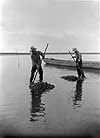Soft and Hard Clams
 |
| Raking in Shallow Water |
 |
| Soft shell clams coming up on conveyer belt. A bottom dredging technique, 1957 |
 |
| Claming in a dory off Chincoteague, Virginia |
The soft clam is one the most common varieties harvested in the Chesapeake Bay. This clam can grow to five inches across but the legal harvest limit is two inches across. The shell is soft and can be crushed with your fingers. The clams live in mud or sand and they are exposed in low tides. They are found from Labrador to North Carolina and are called by different names including "piss-clam," "long-neck clam," "steamer," "Ispwich clam," and "belly clam."
 |
| Soft shell clamming off of Island Creek, Maryland, 1957 |
 |
| Claming with a dredge |
 |
| Raking clams off of Chincoteague, Virginia |
Soft clams are harvested by using a hydraulic dredge from the side of the boat. A water jet is created at the end of a conveyor belt and it cuts a thirty-inch-wide trench in the bottom of the Bay. Everything on the bottom comes up the conveyer and the waterman culls through the belt for the soft clams. The clam's width is measured with a two-inch ring and the rest of the material goes back into the water.The hard clam is another common clam on the East Coast of the United States. This clam can grow up to seven inches across. Hard clams range from Maine to South Carolina in the intertidal zone. The hard clam is also known as the "quahog." 努力蛤收获不同的labor intensive way than soft clams. They are either raked in shallow water with a special clam rake, or harvested withpatent tongs. The rake is scraped across the mud and sand to pull up the clams from the silt. They are then sorted by size and sold. The hard clam is the main ingredient in clam chowder.
|

